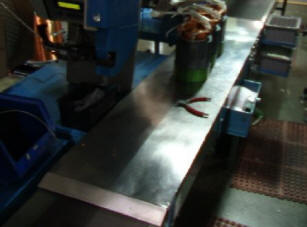 |
| Work surface with both shadow and glare |
Background
In most manufacturing operations, the standard approach to lighting is overhead fluorescent bulbs. Such lighting can be fine, but in many workplaces it can create shadows and glare that interfere with work. Task lighting is generally needed to supplement the overhead lighting, but task lights themselves can have shortcomings. Basic lighting concepts are uncomplicated, but special issues can quickly become complex and a qualified lighting engineer may need to be consulted.
Objectives
Provide sufficient brightness, avoid shadows and glare.
Issues and Options
Overhead lighting
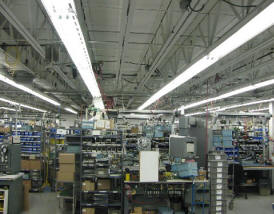 |
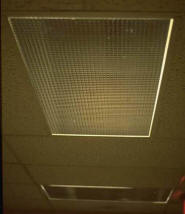 |
| Overhead fluorescent lighting | Mylar grid diffuser directs light down, not to sides |
In most industrial operations, overhead fluorescent bulbs can provide perfectly satisfactory lighting. However, sometimes individual work areas or workstations can be poorly lit. An underlying problem is that lighting is typically installed before machinery and workstations are installed, and as a result, the lighting may or may not be adequate for any given workstation. Furthermore, floor layouts change while lighting usually stays put. Thus, areas that were satisfactory in the past can become problematic as changes are made.
Areas that are dimly lit are easy to identify and remedy. A more subtle issue, however, is when lighting is overly bright.
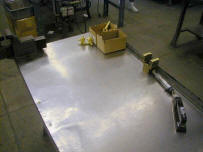 |
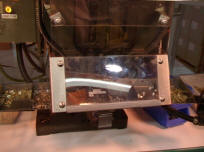 |
| Glare on metal work bench | Glare on safety shield (distorted reflections of round light and long fluorescent bulb) |
One way to check for excessive lighting is to check reflective surfaces for glare, particularly any screens or surfaces that people look at directly. Checking for glare requires deliberate focus, since we tend to automatically tolerate and ignore it. Glare can interfere with work and cause eye fatigue, but we tend to be unconscious of it.
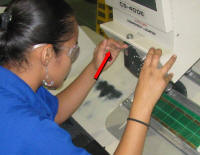 |
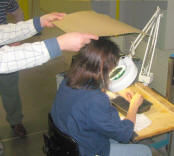 |
| Left hand used to shade work | Testing for excessive light |
Another technique is to watch employee behaviors, such as crooking their necks to compensate for glare or using their hands to shade their work. You can also try shielding workstations from overhead light by holding a piece of cardboard. Employees usually notice an improvement immediately, even if they have been unconscious of excessive light beforehand.
Simple ways to reduce excessive ambient lighting include:
- Remove bulbs or turning off certain lights
- Clip shades to the sides of light fixtures (see example below)
- Add diffusers (a good type is the 1/2 in. Mylar grid which directs light down, but not sideways)
Note that in the office environment, now that computers are used by everyone, ambient lighting is usually dimmed and diffusers are added to light fixtures in order to make computer screens more readable. The same approach is needed for at least some work areas on the plant floor.
Task Lights
 |
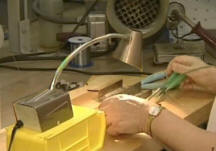 |
| Goose neck task light | Small bench light |
The single best rule of thumb for manufacturing workstations is to provide task lighting rather than rely strictly on overhead lighting. Good task lighting provides control over the direction of the light in order to prevent both glare and shadows.
Standard fluorescent bench lights
 |
 |
| Hot when close | Glare when above workstation |
Fluorescent bench lights are very common and can be suitable for many situations. However, they can be hot if they need to be moved close to the work, plus the articulating arms in some lamps may not be of a sufficient quality to allow precise placement.
Furthermore, as shown in the photo above right, when the lights are not positioned properly, they can create glare and excessive light.
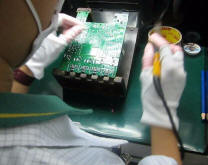 |
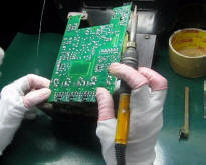 |
| Glare on circuit board makes soldering difficult | Employee tilts circuit board to see |
One of the worst situations is when lights shine directly on reflective products, interfering with the employee’s ability to do the work and increasing likelihood of defects. In the above example, the employee behavior that brought attention to the problem was stopping work to tilt the board to see. The glare was an irritant to the employee and a barrier to productivity.
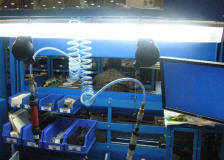 |
 |
| Before: Glare from bare fluorescent bulb | After: Quick fix shade clipped to side of light |
Usually, problems with glare result from reflection off shiny surfaces. However, sometimes the problem is a bare bulb in the line of sight. Normally this sort of problem can be resolved by adding shades to the sides of the lights or purchasing light fixtures that provide better shading.
Head lights
 |
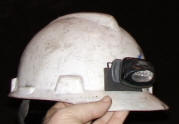 |
| Headband light | Helmet light |
In some situations, such as with maintenance personnel or working on large products that have hidden corners, a good solution is to use head lights. Multiple styles are available on the internet or from industrial suppliers. Small portable shop lights have been used for years for this purpose and provide an excellent option, but the availability of head lights is less widely known and have the advantage of “automatically” being repositioned and providing direct light wherever you look.
Fiber-optic and LED
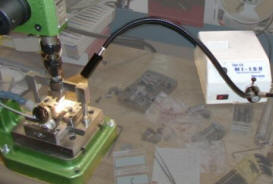 |
| Fiber-optic light |
Fiber-optic light provides a good option when light is needed in a hard-to-access location. The lights are cool, easy to direct precisely where needed, and can provide variable intensity as needed.
 |
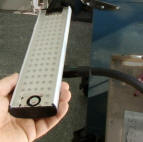 |
| LED bench light | LED underside showing rows of small bulbs |
LED bench lights are cooler and more directional than fluorescent, and may be better workstation light for some purposes. There may be additional uses and advantages for fiber-optic, LED, halogen, and other technologies. Contact vendors or a lighting engineer.
Light box
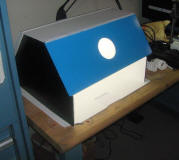 |
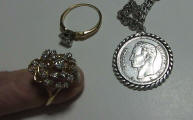 |
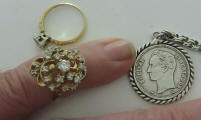 |
| Light box | Jewelry under normal fluorescent bulb | Jewelry in light box |
There are many light boxes available on the market, some with different types of lights inside the box for different purposes. The light box shown above is a prototype developed by the author (dan@danmacleod.com), which has the effect of eliminating glare and providing even lighting (especially difficult with diamonds). A good application is inspection, since it is possible to see tiny items with the naked eye more easily using the light box than with traditional light sources.
Special tasks
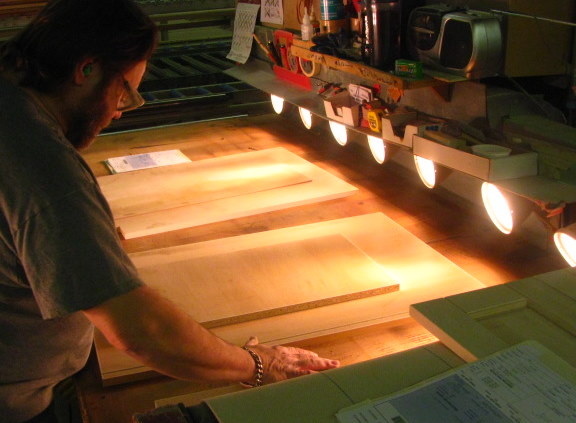 |
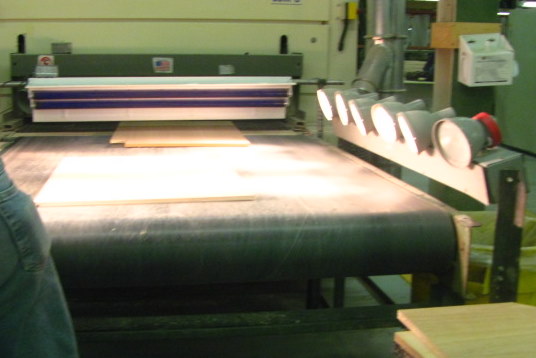 |
| Side lights for checking surface flaws | |
For some tasks, non-traditional types of lightning can be helpful. For example, in some inspection tasks, light is best provided from the side at a very low angle, rather than from overhead.
Lighting technology can quickly become complicated once beyond the basics. For special needs, contact a qualified lighting engineer.
Background color
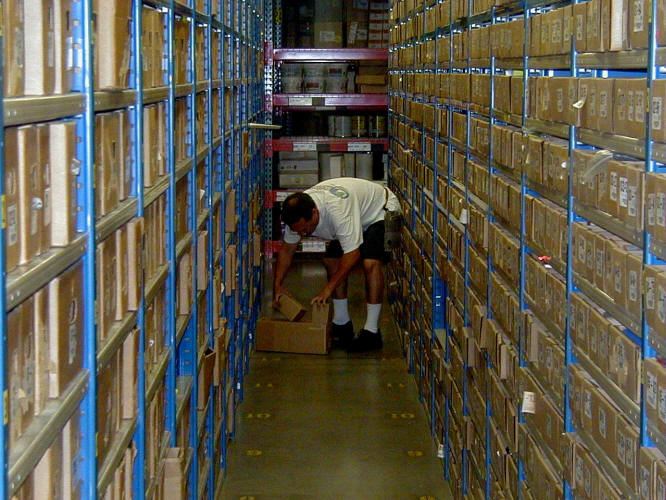 |
 |
| Before: Bin rack with standard cardboard surfaces | After: White-surfaced cardboard |
Painting walls and equipment white or equivalent bright color that reflects light is a common approach to improving visibility in dark areas. The example above shows an innovative variation to this theme.
Storage areas are often dark because the tall racks can block light in narrow aisles. The example shows standard brown cardboard containers that were replaced with white-surfaced cardboard. The change resulted in a noticeable improvement in visibility for order picking.
